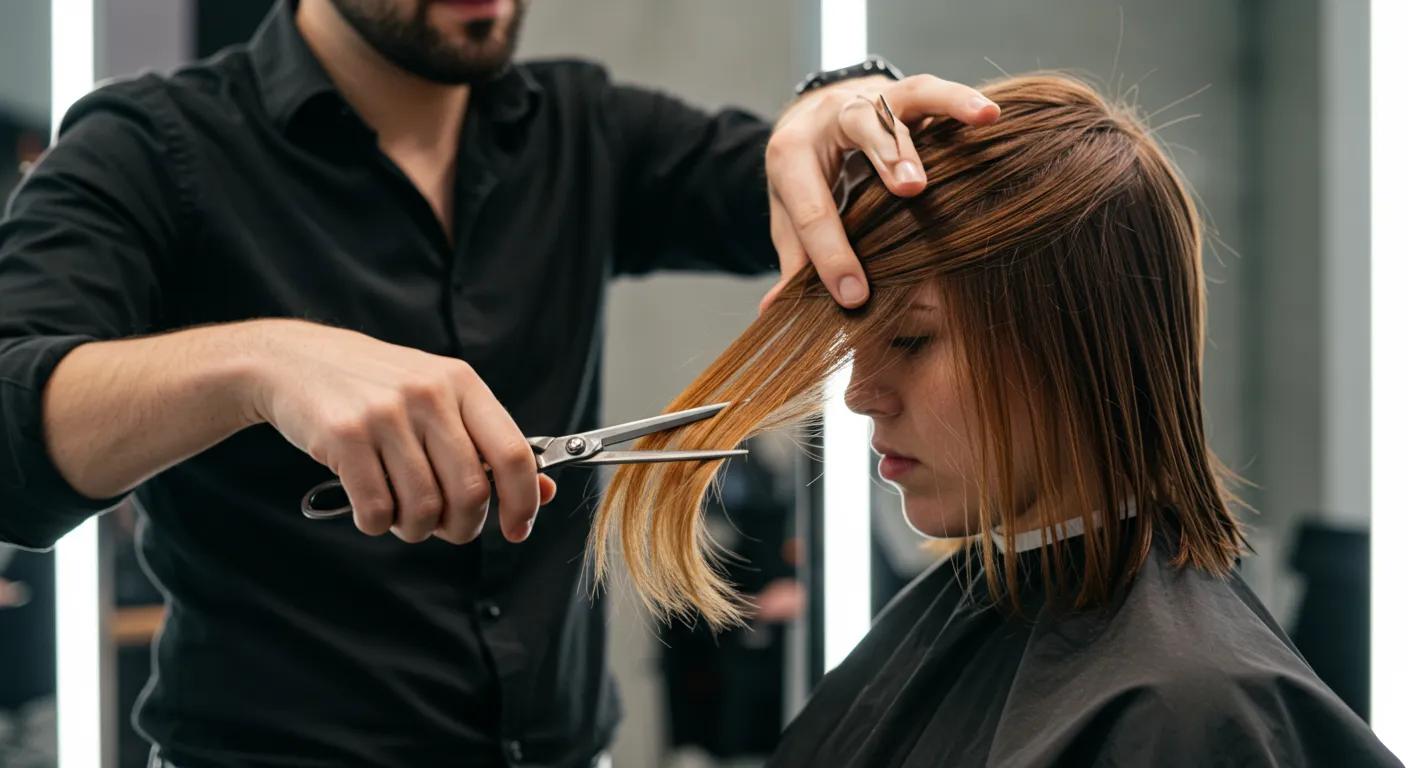Table of Contents
- Why Should You Grow Out Your Hair?
- How Does the Hair Growth Cycle Influence Growing Out Hair?
- How to Grow Your Hair Faster and Healthier: Essential Tips and Practices
- When Should You Trim or Maintain Your Hair While Growing It Out?
- How to Adapt Hair Care for Different Hair Types When Growing Out Hair
- How to Overcome Common Challenges When Growing Out Your Hair
- When Will You See Results? Understanding Hair Growth Timelines and Expectations
- Final Thoughts
- Frequently Asked Questions
This blog post may contain affiliate links. As an Amazon Associate I earn from qualifying purchases.
How to Grow Your Hair: Why, How, and When to Grow Out Your Hair for Healthy Results
Growing out your hair can enhance both your appearance and your confidence. In this article, I share personal insights on hair growth, discuss the benefits of longer hair, explain the hair growth cycle, and offer practical advice on nutrition and maintenance. Whether you struggle with breakage, want to achieve a specific length, or desire fuller hair, understanding the factors that influence growth can lead to better care and results. Follow along for guidance on tailoring your hair care routine to your unique hair type.
Transitioning from short to long hair is more than just an aesthetic change—it requires consistent care, patience, and the right products. Let’s explore why growing your hair is beneficial and which techniques lead to successful hair journeys.
Why Should You Grow Out Your Hair?
Long hair offers versatility in styling and acts as natural protection for the scalp against environmental aggressors like sun exposure and cold weather. Additionally, as hair grows, natural oils help to condition it, reducing breakage and split ends. Growing out your hair also reveals your hair’s unique texture, enabling you to better adjust your care routine—be it with coconut oil, castor oil, or silicone-free cleansers.
What Are the Benefits of Growing Out Your Hair?
Long hair minimizes damage from environmental factors and chemical stress caused by frequent coloring or heat styling, allowing it to regain strength and shine. From personal experience, reducing frequent trims has lessened split ends while increasing volume and thickness when proper deep conditioning and a nutrient-rich diet (including biotin, vitamin D, and zinc) are maintained.
How Do Genetics and Hair Type Affect Hair Growth?
Genetics and hair type determine the apparent growth rate and overall quality of hair. Curly or coily hair may seem to grow slower because of its tight curl pattern, even though the scalp-level growth is similar to that of straight hair. Factors like stress and nutritional deficiencies may further slow growth. A healthy diet rich in protein, omega fatty acids, and vitamins such as folate and vitamin E is essential across all hair types.
When Is the Right Time to Start Growing Your Hair Out?
There is no universal “right time” because it depends on individual hair needs and lifestyles. Many wait until after chemical treatments or periods of damage to begin a natural care regimen. Starting with a healthy base and adopting protective styling and maintenance routines can set the stage for resilient hair growth.
How Does the Hair Growth Cycle Influence Growing Out Hair?

Hair growth is cyclical, with each phase playing a role in overall hair health. Understanding these phases allows you to tailor your care and avoid breakage.
What Are the Stages of the Hair Growth Cycle?
There are three interconnected stages: – The anagen phase is the growth phase, lasting from two to seven years based on genetics and overall health. – The catagen phase is brief—about two to three weeks—where growth stops and follicles shrink. – The telogen phase is the resting stage, lasting roughly three months before old hair falls out and new hair begins to grow.
How Long Does Each Hair Growth Phase Last?
The anagen phase governs potential hair length, whereas the catagen phase is short. Approximately 10–15% of hair is in the telogen phase at any given time. Adjusting your care routine according to these phases (for example, avoiding excessive manipulation during telogen) helps maintain growth.
How Can You Support Each Phase for Optimal Hair Growth?
For the anagen phase, use gentle, sulfate-free cleansers and nourishing conditioners. During the catagen phase, avoid heavy styling or heat treatments. In the telogen phase, improve scalp circulation with massage and nutrient-rich treatments. A balanced diet with proteins, multivitamins, biotin, and vitamin B12 supports all phases of growth.
How to Grow Your Hair Faster and Healthier: Essential Tips and Practices
Achieving faster and healthier hair growth requires both internal nourishment and external care, including a comprehensive routine from daily washing to weekly deep conditioning.
What Hair Care Routines Promote Healthy Hair Growth?
Maintain a routine that preserves natural oils by washing your hair only two to three times a week with a mild, sulfate-free shampoo suited to your hair type. Follow with a nutrient-rich conditioner and add a weekly deep conditioning mask or oil treatment. Use a microfiber towel and avoid excessively hot water and heat styling tools to reduce breakage and preserve natural texture.
Which Hair Care Products Support Hair Growth?
Select shampoos and conditioners infused with biotin, keratin, and natural oils like coconut or castor oil. A dual-action serum can benefit both scalp and strands. Avoid harsh chemicals, sulfates, and parabens to maintain scalp moisture and overall hair health. Products that help maintain the scalp’s pH balance, along with vitamin E and C-infused formulas, further boost circulation and nutrient absorption.
How Does Nutrition Impact Hair Growth?
Hair health reflects overall well-being. Nutritional deficiencies, particularly in proteins, vitamins, and minerals, can lead to hair thinning and loss. Eating lean proteins, leafy greens, and essential fatty acids, as well as ensuring sufficient intake of folate, vitamin D, and biotin, offers building blocks for hair growth. Drinking plenty of water also aids in nutrient transportation to hair follicles.
Below is a table summarizing essential nutrients and their benefits for hair growth:
Integrating these nutrients supports robust hair growth and improves overall hair quality.
When Should You Trim or Maintain Your Hair While Growing It Out?

Regular trimming is essential even when growing your hair. It removes split ends that can hinder growth, striking a balance between preserving length and sustaining healthy strands.
How Often Should You Trim to Avoid Split Ends Without Stopping Growth?
Trimming every eight to twelve weeks is typically recommended to eliminate split ends and prevent breakage. For me, a three-month interval works well, keeping hair strong and shiny without sacrificing much length. Using hair-specific scissors instead of household ones can also reduce split endings.
What Are the Signs You Need a Hair Trim During Growth?
Visible split ends, a dull appearance, persistent tangling, or wiry, frizzy tips signal that a trim is needed. If your hair breaks easily during combing or appears uneven, it is time for a trim to restore balance and improve manageability.
How to Adapt Hair Care for Different Hair Types When Growing Out Hair
Different hair types require distinct care routines to maximize growth without compromising health. Tailoring your approach enhances moisture retention and manageability.
What Are the Best Growth Tips for Straight and Wavy Hair?
For straight or slightly wavy hair, use a lightweight routine. A volumizing shampoo paired with a conditioner for fine hair maintains softness and shine while preventing oiliness. A leave-in conditioner and a heat protectant are useful when blow-drying to avoid limp, over-processed hair.
How Should Curly and Coily Hair Be Maintained for Growth?
Curly and coily hair benefits from extra moisture due to its natural dryness. Use a sulfate-free, moisturizing shampoo and a rich, cream-based conditioner to lock in hydration. A weekly deep conditioning or hot oil treatment (using coconut or castor oil) is ideal, and gentle detangling with a wide-tooth comb minimizes breakage. Protective styling (such as braids or twists) also helps preserve length.
Which Products Work Best for Each Hair Type During Growth?
Choose light, protein-based treatments for straight and wavy hair to boost volume. For curly and coily hair, rich, hydrating products with ingredients like keratin, biotin, and natural oils work best. The table below summarizes recommendations:
Adapting your product choice to your hair type not only maintains natural structure but also minimizes breakage.
How to Overcome Common Challenges When Growing Out Your Hair

Challenges such as hair breakage, thinning, and stress-related shedding can occur during your growth journey. Recognizing these issues early and addressing them helps keep you on track.
What Causes Hair Breakage and How Can You Prevent It?
Hair breakage results from over-manipulation, excessive heat styling, improper brushing, and lack of moisture. To combat breakage, be gentle when detangling, use heat protectants, and apply regular deep conditioning treatments along with natural oils like coconut or castor oil. Reducing chemical treatments and opting for natural styles also help maintain hair integrity.
How to Manage Hair Loss or Thinning While Growing Hair?
Combining topical treatments with nutritional support can manage hair thinning. Ensure your diet is rich in iron, vitamin D, and B vitamins, and include gentle scalp massages to boost blood circulation. Strengthening products featuring keratin and botanical extracts can also reduce thinning, and consulting a dermatologist may rule out underlying issues.
How Does Stress Affect Hair Growth and What Can You Do?
Stress can force more hairs into the resting phase, causing increased shedding. Combat stress with regular exercise, mindfulness, and adequate sleep. Techniques such as meditation or yoga, along with adaptogenic herbs, can fortify your body’s resilience and help maintain a steady hair growth cycle.
When Will You See Results? Understanding Hair Growth Timelines and Expectations
Achieving your desired hair length is a marathon, not a sprint. Setting realistic expectations and periodic goals helps maintain motivation throughout your journey.
How Fast Does Hair Typically Grow Per Month?
On average, hair grows about 0.5 inches per month during the anagen phase, though factors like age, hormone levels, and diet can influence this rate. Monitoring your growth over several months can help you set realistic goals for length and texture improvements.
What Factors Can Speed Up or Slow Down Hair Growth?
Genetics primarily sets your growth rate while a nutrient-dense diet can accelerate it. Conversely, hormonal imbalances, high stress, heat styling, and chemical treatments may slow progress. Maintaining a balanced routine with deep conditioning and nutrient supplementation is key to faster growth.
How Long Does It Take to Achieve Different Hair Length Goals?
The time needed to reach a specific hair length depends on your starting point and target. For example, moving from shoulder length to mid-back length may take around two to three years. Celebrating small milestones along the way can keep you motivated, as every extra inch of healthy hair is a victory.
Final Thoughts
Growing out your hair is a holistic journey that combines understanding hair biology with a tailored care routine and a healthy lifestyle. With regular trimming, proper nutrition, and gentle handling, you can achieve your desired length while maintaining overall hair health. Remember that consistent, small steps pave the way for significant progress—stay patient and celebrate every improvement.
Frequently Asked Questions
Q: Can I make my hair thicker naturally? A: Yes. Enhanced hair thickness is achieved through proper nutrition, gentle hair care techniques, and regular use of natural oils such as coconut and castor oil. A diet rich in biotin, vitamin E, and protein helps your hair follicles produce thicker strands.
Q: How do I make my hair grow faster? A: Focus on a nutrient-rich diet packed with biotin, vitamin D, and zinc, along with a consistent hair care routine. Regular scalp massages, reducing heat styling, and avoiding harsh chemicals are important to boost an already healthy growth rate.
Q: What role does diet play in how fast my hair grows? A: Diet is crucial because hair is primarily made of protein. Essential vitamins and minerals provide the building blocks needed for hair growth. Lean proteins, leafy greens, and essential fatty acids significantly contribute to faster, healthier hair.
Q: How often should I trim my hair to support growth while preventing breakage? A: Trimming every eight to twelve weeks helps remove split ends and prevents further breakage without sacrificing much length.
Q: Are there specific products recommended for different hair types when growing hair out? A: Yes. Straight and wavy hair benefit from light, volumizing products and gentle leave-in conditioners, while curly and coily hair require richer moisturizers and oils for optimal hydration.
Q: Can stress affect my hair growth, and what can I do about it? A: Absolutely. Stress can push more hairs into the resting phase, increasing shedding. Managing stress with exercise, mindfulness, and proper sleep greatly supports healthy hair growth.
Q: How long does it usually take to notice results when trying to grow out hair? A: While results vary, many notice improvements in hair texture and reduced breakage within a few months. Achieving significant length typically takes one to several years, depending on individual growth rates.


